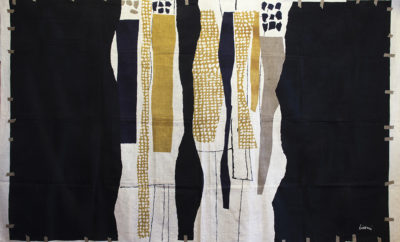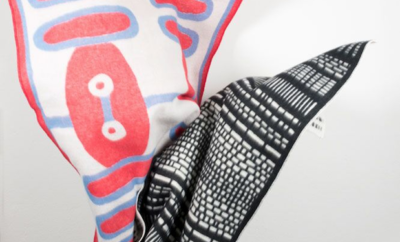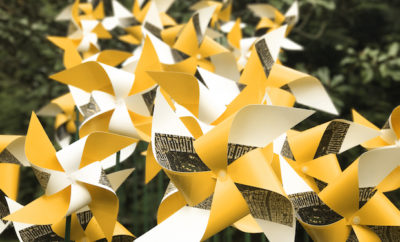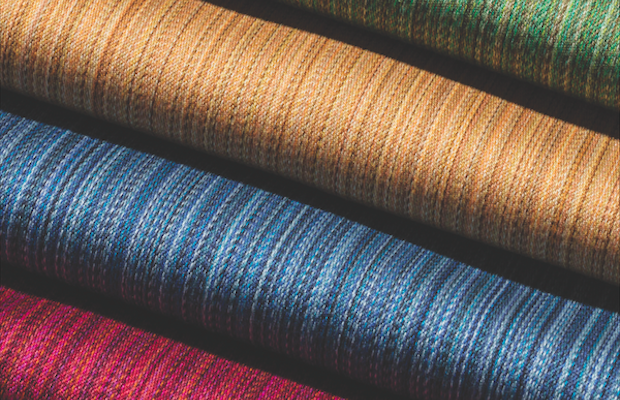 Graham Friedman Photo
Graham Friedman Photo
Feature
Brooklyn’s Rumpelstiltskin: The Innovative Textile Artist Scott Bodenner
IT IS SOMEWHAT UNUSUAL TO HAVE A loom in the dining room, even among professional weavers. But that is what you’ll find when visiting Scott Bodenner in his apartment, located just across from the Brooklyn Museum. Constantly in use, either by Bodenner himself or his assistant, Rachel Bordeleau, the loom is a dobby-type with twenty-four harnesses. It is not ideal for producing large quantities, but that’s not what it’s for. It is a prototyping machine. On this loom, Bodenner tries out new ideas, experiments constantly, and, finally, creates samples that are sent to prospective clients and ultimately to textile mills. From his dining room unspool hundreds of yards of cloth to locations far-flung, and sometimes unknown.
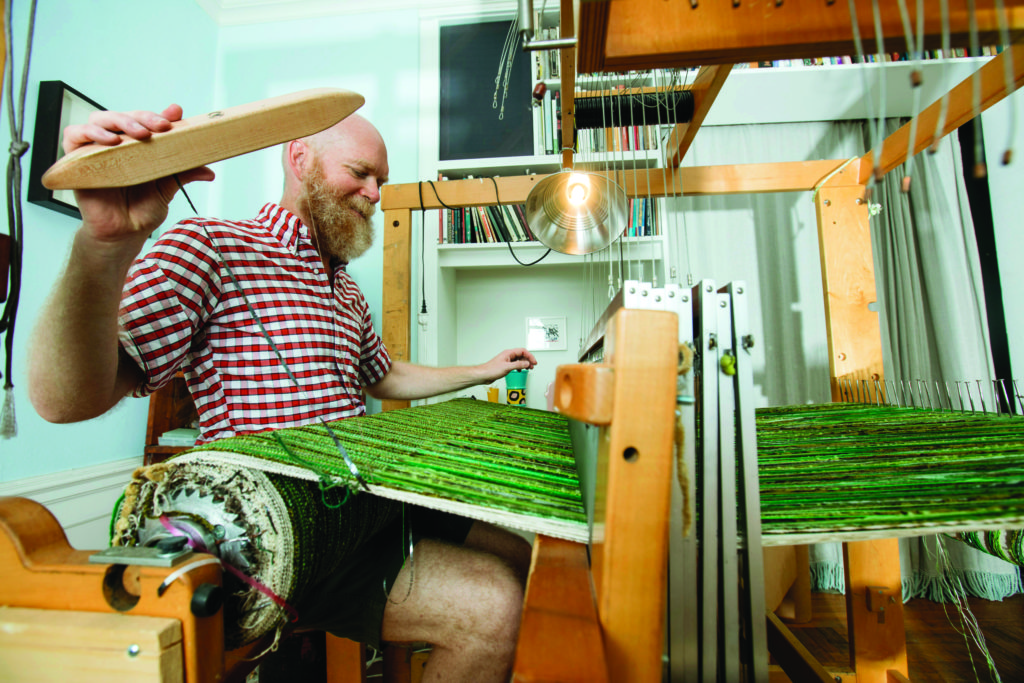
Bodenner weaving on the loom in his dining room. Graham Friedman Photo
Bodenner’s craft-based approach makes him an unusual figure in contemporary textile design, which is now almost entirely conducted at computer screens. It’s not that the digital revolution has left him behind—he is plenty adept with the relevant software—but rather that he prefers to work with materials directly. This sensibility places him in a lineage of American studio weavers going back to the mid-century era, names like Dorothy Liebes and Jack Lenor Larsen. Like those influential figures, he is constantly on the lookout for the advantages of hand-craftsmanship. Among these is the fact that he can use materials that are far outside the ordinary. Liebes pioneered the use of metallic synthetics like Lurex; Bodenner, too, incorporates unconventional yarns in his work, to still more unconventional effect.
A great example is a fabric called Moon Light. Bodenner has loved things that glow in the dark since childhood, and this cloth does just that. By day, it is beautiful and delicate. By night it makes you feel as if you are in a particularly luxurious cabin on the USS Enterprise. Because the warp of a fabric must be held in tension on the loom, Bodenner often uses a standard yarn in that direction, adding his eccentric touches in the weft. Moon Light is composed of a fine Italian linen warp, with a weft yarn made of intertwined linen and thinly slit, luminescent polyester film. The polyester is treated with strontium aluminate, so that it absorbs light and then emits it in the dark.
An even more unusual fabric in the new collection is Mix Tape, which is what it sounds like it might be: a cloth made partly from recycled audiotape. Like everyone who grew up in the 1980s, Bodenner has owned plenty of personalized cassettes—each one a precious record of a moment in time, perhaps the vestige of a friendship or romance. Now that technology has rendered these little time capsules obsolescent, he would put them to a different use, and many of his acquaintances have duly presented him with boxes of old mixtapes for him to weave. He also offers clients the opportunity to have a fabric custom-made “to memorialize a special recording,” a good example of the opportunities afforded by Bodenner’s hand-craftsmanship.
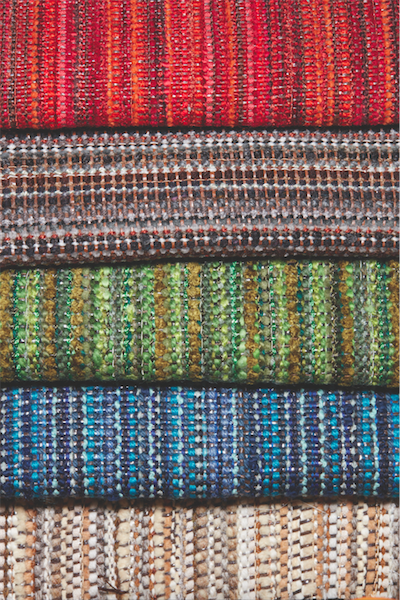
Fabrics from the Mix Tape series, 2017, which, as the name suggests, have recycled cassette tapes woven into the weft. Graham Friedman Photo
Mix Tape incorporates more standard materials, such as cotton, wool, and silk, and these yarns are themselves post-industrially sourced. Thus, the whole fabric is recycled. Bodenner has been motivated by environmentalist concerns since his student days at the Rhode Island School of Design, where he had originally hoped to concentrate on eco-friendly architecture. He was gently dissuaded from this course by the faculty (“hay bales and earth-ships,” he laughs, “were not exactly flying with the architecture professors”) and discovered his métier, but retained the goal of working as much as possible outside the waste stream.
Using recycled yarns may seem like it would be limiting, but for Bodenner it has proved an advantage—again thanks to the flexibility of his craft-intensive process. He’s created a series called Decorator Blend that incorporates odd lots of material from a mill in Pennsylvania. Weaving these salvaged materials raises logistical challenges because they are inconsistent (and might suddenly become unavailable), but he prefers the richness of the palette he gets from reused fibers. The Decorator Blend fabrics have sixteen colors in them: instead of being flat and uniform, the different tints visually combine to achieve an effect of unbelievable depth and sumptuousness, the textile equivalent of an Old Master painting.
Decorator Blend points to the real secret of Bodenner’s success: he is a craftsman who understands industry. Factories serve him both as a source of materials and a field of experimentation. He operates strategically within the constraints of the various mills he works with, whether in the United States, Germany, or Italy. These enormous production facilities are, in effect, his tools, and he has to know their capabilities intimately. Their industrial parameters serve as the exoskeleton for his designs.
So how does Bodenner go from a handwoven sample to a finished fabric that can be ordered in quantity from a showroom? Once he is happy with the material qualities of a design, he draws out the pattern on graph paper, then enters it into what he calls “loom language,” a computer program that speaks directly to the mill’s equipment. The first weaving made in the factory, known as a blanket, is actually a test sampler: it contains a series of minor variations on the design, each of which shows up as a narrow band, perhaps only four wefts’ worth. Bodenner then selects from these subtly different iterations and finalizes the design. While he can imagine what the final fabric will look like, more or less, there are always surprises. Bodenner delights in this unpredictability, the “mystery of the loom.” His work is a testimony to the fact that analog and digital know-how can literally be interwoven to produce a terrific result.
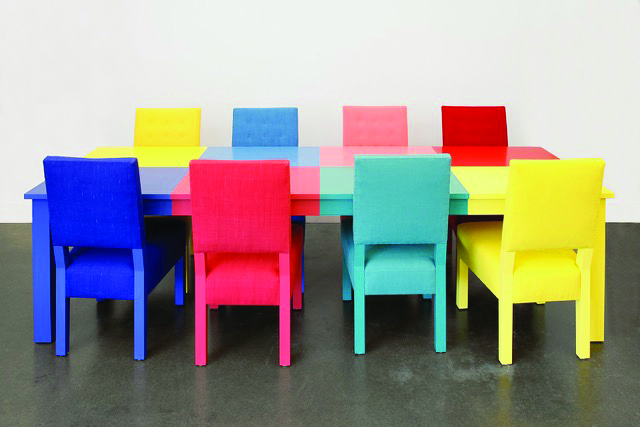
A collaboration with Roy McMakin, 2015, resulted in a mismatched yet cohesive dining set upholstered in handwoven merino wool. Courtesy Roy McMakin and Lora Reynolds Gallery
Bodenner’s key design goal is to “give you something you can engage in, invest in,” whether by imbuing fabric with a spectacular effect (as in Moon Light) or just a quiet but distinct personality, a life of its own. He is also saturated in the history of modernism, and not only of textiles; one of his current offerings, Valkyrie, is populated by aluminum or brass and stainless steel domes inspired by the lighting designs of architect Edward Durell Stone. Bodenner’s voracious curiosity has also led him into collaborations with artists such as Roy McMakin, who occupies an undefined middle ground between furniture and sculpture. In one recent project, the two came together to produce a dining set in which each member of the commissioning family was invited to select colors. The resulting chairs are upholstered in a vibrant dyed handwoven merino wool.
I wondered, when talking to Bodenner, whether the subtle qualities of his designs are really appreciated by the people who encounter them. Once upon a time, textiles were the most concentrated form of wealth that most people were ever likely to see. Embroidered bed hangings made from Indian cotton or a dress fashioned from imported Chinese silk might well be the most expensive items in an aristocratic home. Fabric was so precious that it was handed down again and again, not only from parents to children but also down the social ladder, from gentry to servants. Each successive owner would recut the cloth to fit a new purpose. Such habits survived until relatively recently in the United States, but today, as with so much of our material environment, textiles have gotten much cheaper, and our sensitivity to them has likewise diminished.
Most people today can still appreciate a historical embroidered fabric (one hopes), but how many even know the difference between the main natural fibers—cotton, silk, linen, and wool—to say nothing of the synthetics? How well do people really understand the carefully conceived and executed fabrics that a textile designer like Bodenner makes? I asked him this question, and he had an interesting response: “I think people do like good materials. But we’re in a time when the constraints of production, and the scaling up that our industries require, don’t leave much room for fineness, or actually that much interest.”
When price competition drives the cost of upholstery fabric down too far, it doesn’t allow someone like Bodenner much room to operate. “We have left a more careful consideration of materials behind, for price and production speed,” he says. “However, I think we miss it. I think people want it back—they just don’t have it.” Not usually, perhaps. But thanks to Bodenner and the handful of other craft-based designers working today, at least they have the option.



